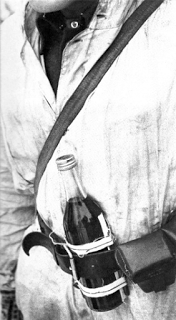1936-2016: 80th anniversary of the anti-tank gasoline bomb. "The Molotov Cocktail as Battlefield Innovation."
Improvised incendiary devices were used for the first time in the Spanish Civil War between July 1936 and April 1939, before they became known as "Molotov cocktails". In 1936, General Francisco Franco ordered Spanish Nationalist forces to use the weapon against Soviet T-26 tanks supporting the Spanish Republicans in a failed assault on the Nationalist stronghold of Seseña, near Toledo, 40 km (25 mi) south of Madrid. After that, both sides used simple petrol bombs or petrol-soaked blankets with some success. -- Wikipedia.
Finnish soldier armed with a Molotov Cocktail.
But even with the knowledge that war might be coming, Finland could only muster a fifth of the manpower and a fraction of the modern weaponry of the USSR and had little advanced weaponry to defeat Soviet tanks. When the Soviets crossed the border in late November, their military planners anticipated a war would last for only a week or two. It lasted until March in no small part because of the Molotov cocktail.
The Molotov cocktail is an elegantly simple weapon, needing only a bottle and some flammable materials like gasoline or tar. Using either a basic fuse or even an old rag, a soldier sets the end on fire and hurls the weapon so the force of impact will shatter the glass and ignite the flammable materials inside. While the weapon was first employed during the Spanish Civil War in 1936, the Winter War was where it first became truly famous. It is also when the weapon got its modern name. The Finns sarcastically named it for the Soviet Foreign Minister, Vyacheslev Molotov, after he claimed Soviet bombers were dropping food aid to starving children in Helsinki. The Molotov cocktail was the perfect accompaniment to “Molotov’s bread baskets.”

10 comments:
Is it true that a 'napalm' type material can be made by mixing gasoline and Styrofoam?
The beads work best.
Try it and see. Use glass or metal to mix. You don't want the gas to eat the mixing dishes.
Use more Styrofoam than gas, and be careful with it. Your results may vary.
Mike, I love a leader with a sense of history!! Thanks.
Reply to first comment:
Yes, Napalm B--the newer type of napalm that was used by the U.S. military in Viet Nam--is made from gasoline, benzene (which exists in tiny amounts in gasoline) and polystyrene (the most obvious source of which is styrofoam).
You can dissolve styrofoam in gasoline until no more styrofoam will dissolve. Try to avoid breathing the fumes. And obviously you should exercise extreme caution. Don't get it on your skin. Gasoline will burn and irritate skin (and long-term exposure will cause cancer) and gelled gasoline is hard to get off if you get it on your skin.
And, of course, it's highly flammable and will burn like hell if ignited. It sticks to everything, so it's much more of a fire hazard than gasoline, which is already quite a fire hazard.
Yes, though you may want to use an additional solvent. There are a number of other thickening agents which can make something a good bit stickier than just gasoline but no less flammable. You can even use food products like a mixture of flour and sugar with gasoline.
Another place to put some improvement is into the delivery system. You can make a pretty reasonable compressed air cannon with plumbing supplies and a compressor, and use a wad to reliably launch bottles.
But against modern personal and vehicle armor, improvements on such basic incendiaries may be of limited use. I think the point is that there are things which can be improvised which will allow determined resistance to counter what would otherwise seem insuperable advantages in materiel. Modern vehicles may not have the same exploitable weakness in their ventilation systems, but as a whole the enemy is certain to have weak points...especially since they won't have any 'rear'.
Both US Rangers, and SF trained me and mine to use Tide, or any other washing powders to mix with gasoline to make Molotov Cocktails. Needs to set a while to avoid making it slippery. The SF said in a pinch, plain old dirt will work as the thickening agent. Tanks can also be made uninhabitable by throwing bleach on them, or sodium hypochlorate (pool chemicals) and they also disable engines. Ammonia will clear a barracks, motor pool, or a vehicle, full strength.
I've learned that "Ivory Snow Flakes" (or just shred bar soap with a cheese grater) can be stirred into gasoline in a double boiler over an electric heat (no open flames, please) will make a Jim-Dandy napalm..But like most things, desperation will be the mother of invention
Maximum effective range 20 feet (if it works) with a 50-50 chance of giving yourself third degree burns. It takes about twenty of them in the hands of men with NO fear of death to knock out ONE APC. Favorite weapon of 18 year old BLM and communist rioters. ---Ray
As Mike has said before, there are no outmoded weapons, only outmoded tactics.
B Woodman
III-per
Post a Comment